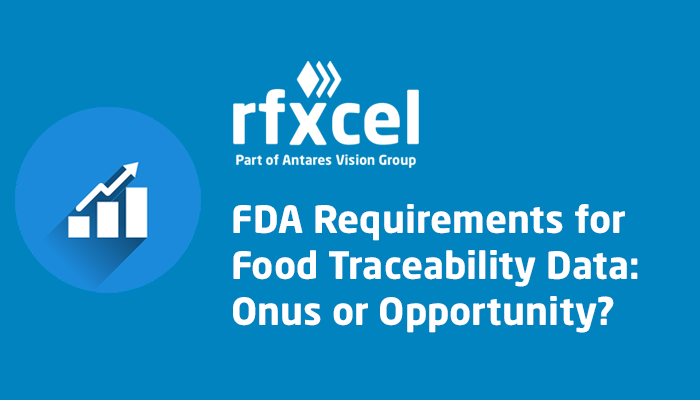As the Food and Drug Administration (FDA) continues to evolve its traceability and modernization initiatives across the U.S. food supply chain, the need for more accurate food traceability data is more important than ever.
Foundationally, the FDA’s initiatives require companies to have digital traceability systems in place that facilitate greater food safety. But food traceability data means more than ensuring you’re complying with regulations: It offers significant business value. Let’s take a look.
FDA’s food traceability initiatives: a refresher
In 2011, Congress enacted the Food Safety Modernization Act (FSMA) to regulate the way foods are grown, harvested, and processed in the United States. The law transforms the nation’s food safety system from an after-the-fact response to foodborne illness to a proactive posture aimed at prevention.
To address the rapid and effective tracking and tracing outlined in FSMA, the FDA in April 2019 launched the New Era of Smarter Food Safety, a tech-enabled approach to food traceability to ensure food safety, and the New Era of Smarter Safety Blueprint (July 2020), which outlined the Agency’s vision for how to get there and included the Food Traceability Proposed Rule, which defines specific traceability recordkeeping requirements for foods on its Food Traceability List.
Food traceability data delivers benefits beyond mere compliance
Although food traceability data serves as the cornerstone of effective recall management and outbreak prevention as required by the FDA, it means much more than compliance. Here are three ways food traceability data can drive business value to support sustainable growth.
Create operational efficiencies
Food traceability data yields complete, real-time visibility into operations across every node in the supply chain. This empowers food companies to take immediate action, solve problems, coordinate with partners and regulators, and keep things moving.
For example, by tracking a product’s ingredients from harvest through production through the last mile to delivery, you can quickly trace raw materials backward and forward, pinpoint supply chain weaknesses or trouble spots, and strengthen your recall program and minimize the impact of recalls. And with a traceability system that allows you to monitor products anywhere in transit, you can collect data on environmental conditions, track the location of all your deliveries, and set precise parameters for alerts.
This food traceability data allows you to proactively protect your shipments, safeguard their environmental integrity, track their position on land, sea, and air, and intervene immediately should something seem awry, such as a spike in temperature or a route diversion. Add critical tracking events (CTEs) and other information (e.g., quality inspections) to the process and you’ve got an indelible product provenance from farm to table.
Build consumer engagement and trust
These days, consumers are more attuned than ever to family health and finances. They want to know more about what they’re eating, such as ingredients, how food is raised or grown, and the safety and environmental practices used to produce it. They want to feel good about what they eat and where they are spending their money. By supplying information that meets this demand, you build trust and loyalty and build a community of customers who will advocate for your products.
The simple truth is that food traceability data creates tremendous opportunities to communicate with consumers and nurture more committed relationships. You can back your claims and prove your product is what you say it is.
Protect your brand
This dovetails with consumer engagement and trust. With modernized, secure, and compliant food traceability protocols, you can better collaborate with partners and authorities if there’s a recall. In this scenario, you’re not only protecting consumers from a health hazard — you’re safeguarding your brand from bad publicity. And with a transparent approach to engaging with customers about the foods they consume, you create a strong brand image that conveys trust, credibility, and reliability. You can even use your food traceability data as a core differentiator in your value proposition messaging.
Final thoughts
Food traceability data has always been important, but the FDA has clearly put it center stage with FSMA, the New Era of Smarter Food Safety, the Food Traceability Proposed Rule, and the Food Traceability List.
Do not expect this to change.
rfxcel believes industry leaders will see traceability as an investment in their businesses and brands, not a compliance mandate from the government. If fact, savvy companies will know the FDA’s initiatives are an opportunity to be involved in shaping the future of the U.S. food supply chain. Keep an eye out this summer for more from rfxcel about how you can tap into the FDA’s initiatives to help lead the transformation of the U.S. food supply chain. As we said above, this is a moment of opportunity for the food industry. Don’t miss the boat.
In the meantime, take a look at our solutions for food and beverage:
- rfxcel Traceability System delivers rich, detailed, comprehensive end-to-end food traceability data that supports operational efficiency, customer engagement, brand security, and compliance.
- rfxcel Raw Materials Traceability can track any ingredient backward and forward in the supply chain.
- rfxcel Integrated Monitoring uses Internet of Things (IoT) technology for real-time environmental monitoring virtually everywhere in your supply chain.
- rfxcel Mobile Traceability app lets you capture vital data and events from virtually any location, no matter where you are.
Contact us today for more information and to schedule a short demo of our food traceability solutions. Get started now and take advantage of all the opportunities food traceability data can create for you.





